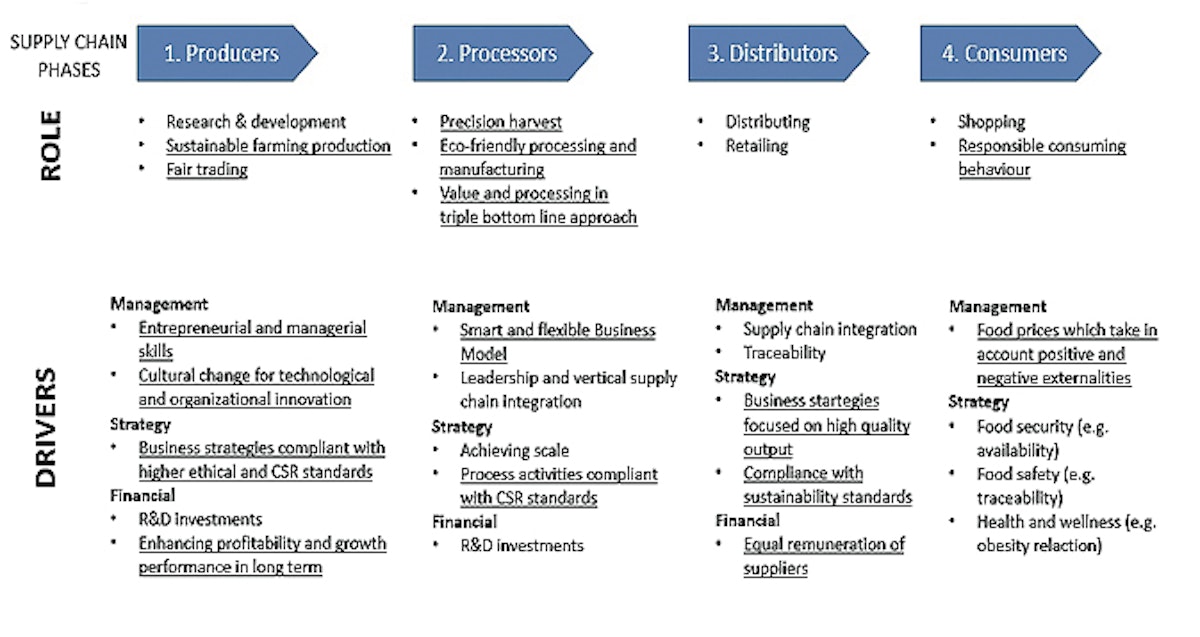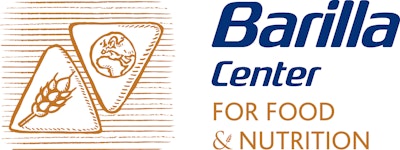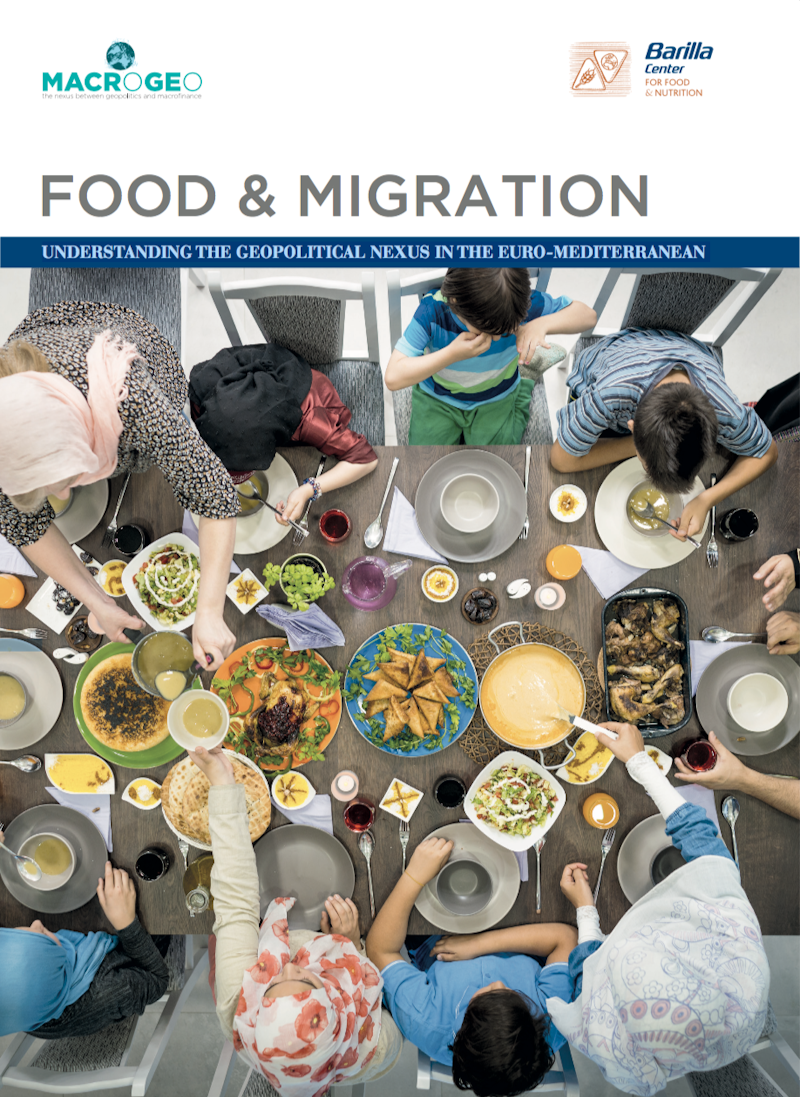Sustainable and innovative food value chains as levers for rural development and migration flows stabilization
by Angelo Riccaboni and Sebastiano Cupertino
The link between inefficient agro-food systems, rural underdevelopment and migrations was underscored by the FAO (2016). Less wealthy inhabitants living in peripheral areas are often forced to move towards urban areas and developed countries in search for new jobs opportunities with the hope to enhance their social and health conditions. Migration flows are driven primarily by demographic unsustainable growth, rural poverty and food insecurity, lack of per capita income, high inequalities between urban and rural areas, limited access to social protection mechanisms, climate change, natural and environmental disasters, and the depletion of resources (FAO 2016).

Given these premises, and taking into consideration the large number of people employed in agriculture and similar activities, especially in developing countries, it is here suggested that agro-food systems and rural development can play a key role to mitigate migration pressures. To this purpose, a number of factors are crucial, starting with the implementation of international and national policies aimed at improving a better use of natural resources and the stabilization of climate change. Policies avoiding oligopolies in production and in distribution of agri-food products and they should eliminate unfair competition are also important for more efficient agro-food systems (Vigani et al. 2015).
To promote more efficient agro-food systems and rural development, and then mitigate migration pressures, also business practices can be relevant. First, legal and economic protection of small businesses and farming activities and stronger cooperation with stakeholders are needed (IEMed 2017). Secondly, global and regional regulations can promote agro-food firms, through direct financing, matching grants, taxation policies, public procurement policies, and recognizing creativity and innovation. Thirdly, banks and financial institutions play a key role in supporting home-grown domestic businesses.
To promote rural development, we should take into consideration also the key role played by Food Value Chains (FVCs), particularly in developing countries and in the Mediterranean area. The expression ‘Value Chain’ means a vertical interaction or a strategic network within different players among a specific supply chain (Hobbs et al. 2000). A FVC is the sum of those processes useful to bring a food product from conception, through the different phases of production, until the delivery of goods to final consumers (Hawkes et al. 2012). FVCs are typical structured networks (see Figure 1) including equipment dealers, seed suppliers, food processors, distributors and even government regulators, consumers (De Pee et al. 2017).
Major weaknesses of FVCs, particularly in developing areas such as African and MENA countries, contribute to an inadequate economic development of rural areas and to food insecurity and unsafety. Consequently, dealing with food and migration it is useful also to defining policies and actions able to deal with such weaknesses, which include:
• losses and wastes along the Value Chains;
• lack of vertical and horizontal integration;
•
lack of entrepreneurship, managerial and technical skills;
• lack of innovation.
1. Losses and wastes along
the Value Chains
Losses and wastes are common in all the phases of the FVCs (pre-harvest, harvesting and initial handling, storage, transport and logistics, processing and packaging, retailing and, finally, consumption activities) (HLPE 2014). This happens with any kind of food commodity, namely cereals, roots and tubers, oilseeds and pulses, fruits and vegetables, meat, fish and seafood, milk. According to WHO (2016), food losses and waste are equal to 1/3 of produced food. At the same time, more than 815 million people all over the world do not have access to adequate food (FAO 2017). Smil (2004) argues for instance that, despite a potential production of about 4,600 kcal per capita, global farming processes, inefficiencies in harvest, transport, storage, and processing produce losses roughly 600 kcal per capita per day. The amount of wastes and losses throughout the phases of the FVC depends heavily on the technologies and production modes used. It also differs in typology and in amount within major world regions, as shown in Figure 2.

Developing countries see more food losses than food wastes while in developed countries food is wasted mainly in the distribution phase. In developing countries, the obsolescence of production and storage facilities contributes to losses through inefficiencies and inability to isolate the product from parasites. Minimizing such losses can have significant economic and environmental impacts, with input savings and carbon footprint reductions. In such situation, innovations in post-harvesting and processing phases would give great returns. Figure 2 shows indeed that in advanced economies the sustainability of food systems is mainly jeopardized by wastes occurring in later stages of FVCs. In particular, inefficiencies are caused mainly by retailers and consumers who produce wastes about 40% of total goods produced (BCFN 2016a; Venkat 2011; Gustavsson et al. 2011).
2. Lack of vertical and horizontal integration
FVC integration is defined as the process through which “supply chain partners interact at all levels to maximize mutual benefits” (SCHUB International 2013). Integration is closely linked to the concept of collaboration, which represents an essential condition for aligning objectives and activities of businesses working in each FVC (Mathu, Tlare 2017). Moreover, according to Han et al. (2013) FVC integration could be a valid response to growing market complexity, because it allows faster decisions, higher profitability for all the partners, greater product quality, higher degree of responsiveness to markets and innovation.
The process of integration in FVCs could assume two different forms, such as vertical and horizontal. While the vertical form leads an integration among economic actors of the same value chain ensuring a higher coordination useful to regulate efficient good flows in terms of quantity, quality and market timing, the horizontal integration refers to cooperation among firms working in the same phase of a same value chain. In any case, both vertical and horizontal integration in FVC are important for the business success, representing two approaches with the same aim to exchange information, competences and knowledge among different players supporting the growth of all of them (Kissoly et al. 2017).
One of the main obstacles to vertical integration is fragmentation, that is a high number of enterprises, as this situation makes it difficult efficient cooperation (Porter 1986). Generally, and particularly in developing countries, FVCs are often characterised by a large number of small actors, which are not able to reach the minimum conditions for survival and for investing in innovation (Bell, Pavitt 1992). At the same time, it should be emphasized that an excessive integration can bring several problems, especially when an entire value chain is in the hands of few actors. In this case, diversity and biodiversity could be not any longer relevant, local values might be overlooked, giving way to ‘manufacturing’ attitude. Furthermore, if the coordination is left only to the power of single actors (Touboulic et al. 2014) or to the market, it is very likely that the smaller actors and those in the first phases of the FVC will suffer, with the advantage of the greater actors and the firms of the distribution phase.
FVCs are often characterised also by a lack of horizontal integration, especially in developing countries. If competitors do not talk to each other, they are probably ‘captured’ by the leader of the FVC and loose market opportunities. Moreover, in developed and particularly in developing countries FVCs are commonly affected also by difficulties in integration within farms and food firms with the other actors of the economic scenario, such as financial institutions, innovators, development cooperation institutions, research centers and consultants (Martí, Mair 2008). The relationships with such actors are key to foster innovation and finding new opportunities. Not being able to relate with them reduce the efficiency of such firms and the capacity to take advantage of new market and innovation opportunities. The typical cultural ‘conservativeness’ of farmers and managers (Menozzi et al. 2015) prevailing in agro-food sector as well as the lack of entrepreneurship could be the main factors to explain such limitation.
The common widespread of fragmentation characterizing food systems both in developed, in emerging and underdeveloped countries leads several small farming and agro-business activities in facing hardly to: operating constraints, which limit their access to public services and credit, in adopting new technologies and in acquiring trade strategic information; market failures, such as higher transaction costs due to less bargaining power with buyers and intermediaries. These limitations especially in rural areas and in absence of integration processes and mechanisms among FVCs penalize a lot farmers and smallholders in developing their business till to drive a large number of those people to migrate in urban or other socio-economically advanced areas.
Filling the gaps of fragmentation in FVCs, the integration among firms could be enabled through the following coordination mechanisms (Handayati et al., 2015; Arshinder et al. 2008):
• supply chain contracts;
• information sharing platforms, using also digitalised systems ICTs-based;
• joint decision-making processes;
• collective learning pathways.
3. Lack of entrepreneurship, managerial and technical skills
Given the complexity of food systems and markets, it is more and more important to couple the agricultural and product knowledge with entrepreneurial capabilities and managerial skills (Mäkinen 2013). Agro-food systems, especially in developing areas, are characterized by the lack of entrepreneurial and managerial skills, due to: (i) the small size of farms and firms (Deakins et al. 2016, Al-Sharafat 2016); (ii) the low levels of education and training, inefficient in enhancing managerial abilities and cultivating future entrepreneurs (Kahan, 2012); (iii) the cultural unwillingness to change management approaches characterizing generally the agro-food sector, particularly many farmers’ decision-making processes (Menozzi et al., 2015); (iv) the gaps of proper incentives and the limited impact of training centers and agricultural extension services (Knickel et al. 2009). These limitations affect negatively the growth and the development of businesses, causing losses in opportunities and jobs till to drive people to migrate from rural to developed areas.
More and more often, decisions should be based on forecasting and the use of reliable financial and market information, giving a strategic value to marketing activities. Product quality, and not cost reduction, should be considered as the driver for success and management control systems and financial analysis tools be introduced. Human capital, international activities and younger generations should be valorised, balancing organisational and technological innovation with the respect of local knowledge and values. Environmental and social sustainability should be considered a strong ally for success and not a constrain for daily activities. On the contrary, most SMEs in the agricultural sector have a deficit in entrepreneurial knowledge and in the application of managerial tools and practices. Such a deficit can be a major obstacle to new business opportunities, to useful horizontal and vertical integration, to internationalization and to the access to credit (Mbogo 2011), vital to ensure fair profitability and to achieve competitive advantages (Deakins et al. 2016).
4. Lack of innovation
Systems often characterized by low entrepreneurial, managerial and technical skills present also less capabilities to innovate.
According to FAO (2014b), innovation in agro-food systems is the process through which individuals or organizations put into use new products, processes or forms of organization to improve efficacy, efficiency, competitiveness, resilience or environmental and social sustainability of agricultural production systems, thus contributing to food security, economic and social development and sustainable management of natural resources. Agro-food firms, smallholders and farmers, especially in developing countries, are very weak in adopting technological and organisational innovations (Drucker 2014).
Lack of entrepreneurial, managerial and technical skills, particularly common within farming and agro-food SMEs in emerging and underdeveloped economies as discussed above, often limit the adoption and the implementation of innovations, reducing both competitiveness and fast business reactions to market, environmental and anthropological changes. These gaps could also act as drivers of migrations. This happens especially in rural areas where farmers and smallholders activities have more difficulties tackling increased adverse context conditions (i.e. market complexity, climate change, limited natural and financial resources, etc.) due to inadequate entrepreneurial attitudes and low both managerial and innovation capabilities.
Innovation is generally seen from a technological point of view. Technological innovation is the implementation of a new product or process that involves new techniques and equipment used to produce goods or services. Organizational innovation is certainly not less relevant than technological innovation for business success. Non-technological innovation in agro-food includes the introduction of organizational practices that are new or significantly improved and the adoption of those that were developed by other companies or organizations (Caiazza et al. 2014). Organizational innovations in business practices include implementation of new procedures, routines among human resources, and division of labour. New organizational methods in external relations also involve the implementation of changes in networking with external private or public participants (Baregheh et al. 2012). In order to provide adequate market responses and renewed internal needs, it is often essential for businesses to introduce changes in management, organizational structure, internal and external reporting, management and operational mechanisms, and accounting technical instruments (Riccaboni, Giovannoni 2005).
Technological and organisational innovation in the agro-food sector needs to be sustainable from an environmental perspective and socially inclusive. A sustainable perspective is important not only for ethical reasons and in the interest of human mankind and future generations, but also for business reasons. These include the following:
•
food systems have a great impact on the environment, and therefore without attention to it, activities of any firm and farm can be at risk (Ericksen et al. 2009);
•
consumers are showing greater attention to
sustainable development issues, opening new market opportunities (Vermeir, Verbeke 2008);
•
being sustainable can allow savings in the use of costly resources such as water and energy (Willard 2012).
Introducing sustainable innovations in the agro-food sector is not easy in both developed and developing countries. Besides a greater awareness of the above cited advantages, it is necessary not only to find concrete technological, social and organizational solutions but also:
•
to re-orient mindsets and behaviours towards a sustainable development perspective, careful about social principles, the impact of activities on natural resources, and the nexus between water, food and energy (FAO 2014a);
•
to strengthen partnership and institutions dedicated to innovation and to the funding of
innovation, engaging all stakeholders, especially those from the private sector (Larsen et al. 2009).
The extent to which institutions contribute to sustainable agro-food systems and FVCs varies by country and by type of institution. In any case, the use of emerging technologies and indigenous knowledge requires adjustments in existing institutions and infrastructures, adapting innovations to local conditions and values. It is fundamental to take advantage of the relationships between any food product and its place of origin, with its values, principles and traditions (Belletti et al. 2017).
In any case, new approaches need to be adopted to promote close interactions among government, business, farmers, academia, and civil society (Lachman 2013). Positioning sustainable agro-food systems as a knowledge-intensive structure requires changes in existing learning institutions, especially universities and research institutes. Key functions such as research, teaching, agricultural extension services, and consulting need to be more closely integrated. Research and innovation initiatives should be taken according to a joint programming perspective, as environmental and social challenges do not know national borders. Institutions should promote agricultural trade and help integrate economies into world markets. They are fundamental also to human development, including the delivery of health and education services. Institutions can contribute also providing agriculture-related facilities able to increase productive capacities of farmers and providing working capital and long-term credit availability (Rundgren 2016).
Concluding remarks
We have just underscored that to improve the efficiency of food systems and rural development, shifting to more sustainable Food Value Chains is essential. Producing and transferring value along the food systems in more sustainable ways means that each FVCs partner should activate synergies to change competitive seller-buyer interactions in cooperative common way (Simatupang, Sridharan 2002). Producers, processors and distributors should share goals, managerial capabilities, resources in terms of knowledge, technologies, data, employees, strategies and profitability.
Cooperation among partners is key to introduce innovative economic or legal mechanism for a fair distribution of profitability among partners of the FVC. This is a crucial theme to promote rural development (FAO 2014c). Without a fair distribution of profitability, the weaker partners, usually the rural ones, will not survive. In order to make the leader of the FVC accept such fair distribution, goals, initiatives and operations must be shared and decided together. A new way of doing business needs to be defined, able to produce a higher added value, so that everyone can be given the right return on his investments and efforts.
Therefore, consumers’ needs are better fulfilled in terms of improved product quality and services. This breakthrough might induce, in turn, even more robust forms of coordination along FVCs through the implementation of technological and organisational innovations and strategies able to foster a better use of raw materials and natural resources.
The diffusion of more sustainable FVCs could help dealing with food insecurity through the integration of cooperative public-private activities implemented by different stakeholders (governments, firms, educational and financial institutions, scientific R&D and innovation units, NGOs, consumers’ associations, farmers, etc.), in order to co-create and spread added-value by technological, organizational and social innovations (Chesbrough et al. 2006), useful in integrating social-environmental externalities in food value and in boosting sustainable development locally and globally. All this could ensure new worthy job opportunities, fair business partners profitability and salaries, reliable supply contracts for SMEs and farmers, and affordable and healthy food (Touboulic 2015; FAO 2014c).
FAO (2014c) argued that Sustainable FVCs (SFVCs) might promote growth loops in terms of investment, economic effects, and progress (see Figure 3).

According to this approach, the enactment of the three loops leads to positive impacts on the economic, social and environmental dimensions of sustainable development. In synthesis, SFVCs are the engine for enhancing working conditions, improving financial, environmental, social and farmers’ performance, enabling environment, increasing consumer benefits, and intensify taxes revenues. This process can also support rural development around the world, leading to the reduction of hunger, inequality and finally stabilizing migration flows (FAO 2014c). Taking into consideration such sustainable development perspective, the traditional FVCs archetype presented above can be represented as shown in Figure 4.

More sustainable FVCs imply a bottom-up approach followed by all economic actors, pointing out that the needs of entrepreneurs, managers and farmers should be moved by greater environmental and social awareness and higher pro-activity in cooperation and innovation (Porter, Kramer 2011).
Sustainable business models should be defined at the level of both single organizations and the whole chain (Varsei et al. 2014), together with common managerial and financial tools and strategies able to support R&I activities along the FVCs.
Public-private investments should be allocated in cooperative R&I activities, to implement entrepreneurial and managerial skills, improved by capacity building processes and knowledge sharing activities among producers, processors and distributors. Businesses involved in sustainable FVCs should adopt innovative business models useful to support proactivity, strategic orientation, collaboration, management control mechanisms, integrated performance measurement systems and risk management (Beske et al. 2014).
Involvement of public and private economic actors should play a crucial role in solving complex and transversal issues about global and regional current agro-food systems, starting from those as weak as the African ones, and their related food value chains. This effort could be able to foster an extensive sustainable economic growth, the preservation of biodiversity, a general improvement in health by affordable food and increased quality of diets, and finally a normalization in migration dynamics.
Dealing with weaknesses of FVCs and promoting sustainable food systems can contribute to deal with migration flows aim, also in compliance with SDG 2 and SDG 12.3 of Agenda 2030 (UN 2015), which involve collaborative partnerships among different players (policymakers, researchers, legislators, investors, farmers, manufacturers, retailers, educators and consumers). In short, more sustainable, integrated, profitable and entrepreneurial FVCs can play a key role to improve food security and safety, fostering, at the same time, rural development and stabilization of migration flows.


